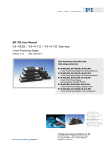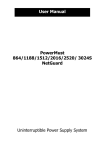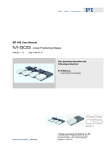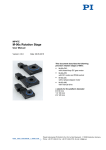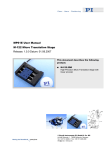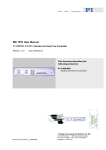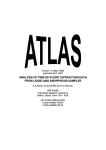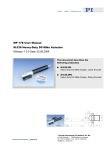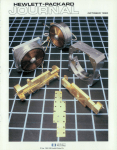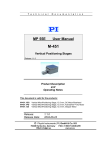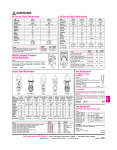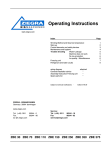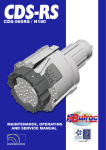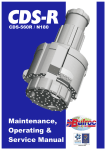Download User Manual MP42E - Physik Instrumente
Transcript
MP 42E User Manual M-126 Series Release: 2.7.0 Linear Positioning Stages Date: 2008-04-24 This document describes the following products: M-126.M01 Linear Positioning Stage, manual operation M-126.CG1 Linear Positioning Stages, DC-Motor / gearhead, compact design M-126.DG1 Linear Positioning Stages, DC-Motor / gearhead M-126.PD1/M-126.PD2 Linear Positioning Stages, DC-Motor direct drive M-126.2S1 Linear Positioning Stages, stepper motor drive © Physik Instrumente (PI) GmbH & Co. KG Auf der Römerstr. 1 ⋅ 76228 Karlsruhe, Germany Tel. +49-721-4846-0 ⋅ Fax: +49-721-4846-299 [email protected] ⋅ www.pi.ws Declaration of Conformity according to ISO / IEC Guide 22 and EN 45014 Manufacturer: Manufacturer’s Address: Physik Instrumente (PI) GmbH & Co. KG Auf der Römerstrasse 1 D-76228 Karlsruhe, Germany The manufacturer hereby declares that the product Product Name: Linear Positioning Stages Model Numbers: M-126.xxx Product Options: all complies with the following European directives: 2006/95/EC, Low voltage directive 2004/108/EC, EMC-Directive 98/37/EC, Machinery Directive The applied standards certifying the conformity are listed below. Electromagnetic Emission: EN 61000-6-3 Electromagnetic Immunity: EN 61000-6-1 Safety (Low Voltage Directive): EN 61010-1 Safety of Machinery: EN 12100 April 14, 2008 Karlsruhe, Germany Dr. Karl Spanner President The following designations are protected company names or registered trademarks of third parties: Windows, LabView Physik Instrumente (PI) GmbH & Co. KG is the owner of the following company names and trademarks: ActiveDrive™ Copyright 1999–2008 by Physik Instrumente (PI) GmbH & Co. KG, Karlsruhe, Germany. The text, photographs and drawings in this manual enjoy copyright protection. With regard thereto, Physik Instrumente (PI) GmbH & Co. KG reserves all rights. Use of said text, photographs and drawings is permitted only in part and only upon citation of the source Document Number MP 42E, Release 2.7.0 M-126UserMP42E270.doc This manual has been provided for information only and product specifications are subject to change without notice. About This Document Users of This Manual This manual is designed to help the reader to install and operate the M-126 Series Linear Positioning Stages. It assumes that the reader has a fundamental understanding of basic servo systems, as well as motion control concepts and applicable safety procedures. The manual describes the physical specifications and dimensions of the M-126 Series Linear Positioning Stages as well as the procedures which are required to put the associated motion system into operation. This document is available as PDF file. Updated releases are available for download from www.pi.ws or by email: contact your Physik Instrumente Sales Engineer or write [email protected]. Conventions The notes and symbols used in this manual have the following meanings: WARNING Calls attention to a procedure, practice or condition which, if not correctly performed or adhered to, could result in injury or death. CAUTION Calls attention to a procedure, practice, or condition which, if not correctly performed or adhered to, could result in damage to equipment. NOTE Provides additional information or application hints. Related Documents The motion controller and the software tools which might be delivered with M-126 Series Linear Positioning Stages are described in their own manuals. All documents are available as PDF files.. For updated releases visit download section of the PI Website (www.pi.ws), contact your Physik Instrumente Sales Engineer or write [email protected]. ! Contents 1 Introduction 1.1 1.2 1.3 1.4 Safety Precautions .................................................................... 3 Prescribed Use .......................................................................... 4 Features .................................................................................... 4 Model Survey............................................................................. 5 1.4.1 1.4.2 1.4.3 1.4.4 1.4.5 1.4.6 1.5 2 Unpacking.................................................................................. 8 2.2 2.3 Cable Connector Position........................................................... 9 Sled Attachment ......................................................................... 9 Interconnecting the System ..................................................... 11 Host PC ................................................................................... 11 Operational Considerations 3.1 3.2 3.3 3.4 3.5 M-126.M01 ............................................................................... 17 M-126.CG1 ............................................................................... 18 M-126.DG1 ............................................................................... 19 M-126.PD1 and M-126.PD2 ..................................................... 20 M-126.2S1 ................................................................................ 21 Accessory Z-Axis Mounting Bracket........................................ 22 Disposal................................................................................... 23 Connector Pin Assignments 5.1 www.pi.ws 15 Dimensions.............................................................................. 17 4.1.1 4.1.2 4.1.3 4.1.4 4.1.5 4.2 4.3 12 PWM Amplifiers & Brake Signal .............................................. 12 Limit Switches.......................................................................... 12 Reference Switch .................................................................... 13 Incremental Position Sensor.................................................... 13 Operation................................................................................. 13 M-126 Technical Data 4.1 5 9 Mechanical Mounting................................................................. 9 2.1.1 2.1.2 4 M-126.M01 ................................................................................. 5 M-126.CG1 ................................................................................. 6 M-126.DG1 ................................................................................. 6 M-126.PD1 ................................................................................. 6 M-126.PD2 ................................................................................. 7 M-126.2S .................................................................................... 8 Installation 2.1 3 3 24 M-126.CG1, M-126.DG1 DC Motor ......................................... 24 M-126 Series MP 42E Release 2.7.0 Page 1 Contents 5.2 M-126.PD1, M-126.PD2 PWM DC Motor ................................ 25 5.2.1 5.2.2 5.3 6 M-126.2S1 Stepper Motor ....................................................... 26 Appendix I: Current Controllers 6.1 6.2 Parameter Settings for C-863 Mercury™ DC Motor Controllers29 Parameter Settings for Other DC-Motor Controllers ................ 30 Appendix II: Older Controllers 7.1 7.2 31 Discontinued Stepper Motor Controllers.................................. 31 Discontinued DC-Motor Controllers......................................... 32 7.2.1 7.2.2 7.2.3 7.2.4 www.pi.ws 27 Stepper Motor Controller ......................................................... 27 DC-Motor Controllers............................................................... 28 6.2.1 6.2.2 7 Controller Connector ................................................................ 25 PWM Amplifier Supply Power .................................................. 25 Parameter Settings for C-842 PC ISA-Bus Card ..................... 33 Parameter Settings for Older C-848s & C-880s....................... 33 Parameter Settings for C-844................................................... 34 Parameter Settings for C-862 Mercury..................................... 35 M-126 Series MP 42E Release 2.7.0 Page 2 Introduction 1 Introduction M-126.xxx are leadscrew-driven translation stages with travel ranges of 20 mm and 25 mm. Precision crossed roller bearings guarantee straightness of travel of better than 2 µm. 1.1 Safety Precautions Read this before operating the linear stages: WARNING—Crush Hazard Never put your finger where the moving platform, the motor or any connected object could possibly trap it! The moving platform and motor can accelerate rapidly and generate high forces, which can cause damage or injury. WARNING—Avoid Damage/Injury When mounting the stage keep in mind that the motor will move with the platform and possibly might trap your finger or any equipment! Make sure that there is sufficient clearance for the motor when it and the platform move. ! CAUTION—Avoid Damage Be aware that the stage could start an unexpected move when first connected to the motor controller. Be aware that failure of the motor controller may crash the stage against a hard stop. High-speed crashes can cause irreparable damage. Do not disable limit switches in software. Test limit switch operation at low speeds. Be aware that overlength mounting screws will interfere with motion and may cause permanent damage! Never connect a stepper motor to a DC motor controller or a DC motor to a stepper motor controller. Irreparable damage could result. www.pi.ws M-126 Series MP 42E Release 2.7.0 Page 3 Introduction 1.2 Prescribed Use Correct operation of the M-126 Series Linear Positioning Stages is only possible in combination with a suitable controller/driver (ordered separately) and software. The controlling device must be able to read out and process the signals from reference and limit switches and the incremental position encoder to ensure proper performance of the servo-control system. Based on their design and realization, these stages are intended for single-axis positioning, adjusting and shifting of loads at various velocities. M-126 Series Linear Positioning Stages can be mounted horizontically or vertically. To achieve the specified guiding accuracy, the positioners have to be mounted on a flat surface to avoid torsion of the basic profile. The positioners may only be used for applications suitably in accordance with the device specifications. Respect the safety instructions given in this User Manual. The operator is responsible for the correct installation and operation of the stages. The verification of the technical specifications by the manufacturer does not imply the validation of complete applications. In fact the operator is responsible for the process validation and the appropriate releases. The M-126 Series Linear Positioning Stages meet the specifications as defined by DIN EN 61010 for safe operation under normal ambient conditions. See the specifications table for details. 1.3 Features Models are available with the following features www.pi.ws 20 or 25 mm Travel Ranges Crossed Roller Bearings DC Servo or Stepper Motor Drive < 0.1 µm Resolution ActiveDrive™ Manual Knob for Ease of Operation (all models) Choice of Motor Controllers M-126 Series MP 42E Release 2.7.0 Page 4 Introduction 1.4 XY and XYZ Combinations Non-contacting, Hall-effect limit and reference switches Reference switch with direction sensing Model Survey The platform portion of all models is the same with travel range of 25 mm, except for M-126.PD2 with 20 mm. Non-contacting, Hall-effect limit switches are integrated in motorized versions to help prevent overtravel. All current models also have a direction-sensing reference switch. All stages can be cross stacked and/or combined with the M-125.90 Z-axis mounting bracket to provide multi-axis motion. The differences between the various models lie in the drive section. They are shown in the table below and described in detail in the sections that follow. Model M-126.M01 M-126.CG1 M-126.DG1 M-126.PD1 M-126.PD2 M-126.2S1 Drive type Manual micrometer DC compact, 2W DC, 3 W (C136.10) DC, 30 W PWM drive stepper motor, 2phase Position sensor No Yes Yes Yes No Directionsensing reference switch No Yes, but not in older M-126.CG Yes, but not in older M-126.DG Yes, but not in older M-126.PD Yes, but not in older M-126.2S 1.4.1 M-126.M01 Manual-drive stage, equipped with a high-precision leadscrew for thumbscrew operation, features excellent resolution and repeatability. Fig. 1: M-126.M01 www.pi.ws M-126 Series MP 42E Release 2.7.0 Page 5 Introduction 1.4.2 M-126.CG1 Utilizes a compact closed-loop DC motor with shaft-mounted highresolution position encoder and a precision gearhead providing 0.1 µm incremental motion. Fig. 2: M-126.CG1 1.4.3 M-126.DG1 Equipped with a larger motor than M-126.CG1 and provides higher velocity at the same incremental motion of 0.1 µm. Fig. 3: M-126.DG1 1.4.4 M-126.PD1 * * The M-126.PD1 and M-126.PD2 versions have integrated PWM amplifiers and require connection of a separate power supply, an E-500.PS or 20683. The newer, more compact 20683 power supply comes with the K050B0002 adapter required to plug it into the stage. K050B0002 adapter shown between 20683 PS barrel connector and DC IN socket on M-126.PDx stage. www.pi.ws M-126 Series MP 42E Release 2.7.0 Page 6 Introduction Equipped with a 30 W ActiveDrive™ DC motor providing 0.25 µm minimum incremental motion and velocity up to 15 mm/sec. The novel ActiveDrive™ concept features an integrated, high-efficiency power amplifier and reduces overall system cost. The stage can be driven directly from a PC-motor controller (e.g. C-842, Mercury). M126.PDx stages come with a power supply which supplies the built-in amplifiers directly. Fig. 4: M-126.PD1 and M-126.PD2 (shown) have the same dimensions 1.4.5 M-126.PD2* The M-126.PD1 and M-126.PD2 versions are the same size but differ in their travel ranges of 25 and 20 mm respectively. Furthermore, the M-126.PD2 is equipped with a ballscrew with 1 mm pitch, while the M-126.PD1 has a precision drive screw, pitch 0.5 mm. The M-126.PD1 and M-126.PD2 versions have integrated PWM amplifiers and require connection of a separate power supply, an E500.PS or 20683. www.pi.ws M-126 Series MP 42E Release 2.7.0 Page 7 Introduction 1.4.6 M-126.2S Equipped with a 2-phase micro-stepping stepper motor offering a design resolution of 80 nm in conjunction with the C-663 Mercury® Step stepper motor controller (resolution differs with older controllers, see Section 7.1). Fig. 5: M-126.2S1 1.5 Unpacking Unpack the M-126 stage with care. Compare the contents against the items covered by the contract and against the packing list. Inspect the contents for signs of damage. If parts are missing or you notice signs of damage, such as loose contacts or hairline cracks, please contact PI immediately. Save all packing materials in case the product need be shipped again. www.pi.ws M-126 Series MP 42E Release 2.7.0 Page 8 Installation 2 Installation 2.1 Mechanical Mounting WARNING—CRUSH HAZARD When mounting the stage keep in mind that the motor will move with the platform and possibly might trap your finger or any equipment! Make sure that there is sufficient clearance for the motor when it and the platform move. 2.1.1 Cable Connector Position Before mounting one of the motorized versions, decide whether or not the cable connector is in a suitable position. Because the platform and motor normally move together, proper clearance and cable slack will be required. To change connector orientation, loosen the 2 set screws which clamp the motor housing with an Allen wrench (shown) and rotate the housing and connector to the desired position (arrows). Then retighten the set screws. NOTE Motor may be rotated about its axis as desired to change cable connector orientation (Fig. 6). Fig. 6: Changing connector orientation 2.1.2 Sled Attachment The stage is usually mounted with the sled (bottom side of the stage, see Fig. 8) firmly bolted to a base plate or another stage. Note that this means that not only the spindle-driven platform moves, but also the motor and cable. ! CAUTION Be aware that overlength mounting screws will interfere with motion and may cause permanent damage! www.pi.ws M-126 Series MP 42E Release 2.7.0 Page 9 Installation Use the two clearance holes on the top of the platform (see Fig. 7) to access mounting holes in the sled (see Fig. 8). Please note that you have to drive the unmounted stage to the proper position so that the holes line up exactly. When this is done, insert the mounting screws (screw set # 000011348; 6 x hex head cap screw M4x18, comes with the stage) from the top side in the holes until the screw heads are tight and do not interfere with stage motion. Clearance holes in the platform for mounting hole access Fig. 7: M-126 stage, seen from the top side (motor moves with platform) NOTE The platform and motor move as a unit, as the stage is mounted by the sled. The positive direction of motion is away from the end where the motor is mounted (see Fig. 8). Mounting holes in the (stationary) sled arrow shows positive (+) motion of platform (and motor!) Fig. 8: M-126 stage, bottom view Adapter plates and mounting brackets are available for stacking M126 series stages to form XY- or XYZ-systems. See p. 22 and the PI catalog at www.pi.ws for more information, or contact your PI Sales Engineer. To mount an object on the platform, use the threaded mounting holes and M4 screws. www.pi.ws M-126 Series MP 42E Release 2.7.0 Page 10 Installation 2.2 Interconnecting the System Motorized versions of the M-126 series can be internetworked with other PI micropositioning stages in many different combinations, including: 2.3 Mercury Class devices can be daisy chained off a single RS232 or USB port, meaning that even stepper and DC motors (PWM and analog) can be networked together (with C-663 and C-863 controllers) PWM and DC-motor devices can be mixed on the current models of the multi-axis controllers (with C-843, C-848, C-880). With the PWM stages, be sure to connect the separate power supply to the stage, using the K050B0002 barrel-to-Switchcraft adapter if necessary. Host PC Most PI controllers are in turn controlled by a host PC provided by the user. The only exceptions are programmable controllers with standalone mode (C-862 Mercury), controllers with a joystick port or manual control pad. The controller is either installed directly in the PC (e.g. C-843) or connected to it over a communications interface. See the controller User Manual for details. PI generally provides software and/or drivers that run on the host PC to control the system. Typically there will be a control program with a graphic user interface for testing and simple operation, and, in addition, DLL, COM and/or LabView drivers for users who wish to use custom software. If the controller is a PC ISA or PCI card, there will also be hardware drivers to install. See the controller User and Software manuals for installation details. ! CAUTION—Avoid Damage Check Limit Switch Operation The limit switches do not stop the motor directly. Instead, each limit switch controls an overtravel signal on its own dedicated line to the controller. The controller is then responsible for stopping motion. If it does not do so in time, the stage will run into the hard stop. At high speeds, this can permanently damage the stage. www.pi.ws M-126 Series MP 42E Release 2.7.0 Page 11 Operational Considerations 3 Operational Considerations 3.1 PWM Amplifiers & Brake Signal The M-126.PD1 and M-126.PD2 stages with the ActiveDrive™ direct DC-motor drive have the platform connected directly to the 30-watt DC motor by a flexible coupling. For maximum dynamic performance, the DC servo-motors are driven by high-efficiency PWM power amplifiers integrated into the stages. An external plug-in power supply (order number: M-500.PS) is provided to supply the built-in amplifiers directly. This architecture allows high torque and high velocities while loading the motor controller with control signals only. The actual power is provided by the external supply. All current PI controllers can drive either analog or PWM stages by operating in the corresponding mode. NOTE Be sure your software turns the brake OFF before operation, even though standard M-126 stages are not equipped with brakes. If the signal on the brake line from the motor controller (pin 1) is in the Brake ON state (0 V), the PWM amplifier output to the motor is disabled and no motion is possible. 3.2 Limit Switches All M-126 motorized stages are equipped with non-contacting, Halleffect limit switches (with TTL drivers). On stepper-motor versions, limit switch outputs are active low, on other versions, active high. Each limit switch controls an overtravel signal on its own dedicated line to the controller. It is the controller that is then responsible for stopping motion. If it does not do so in time, the stage will run into the hard stop. Should this happen, it may be necessary to push the stage manually out of the end zone. ! www.pi.ws M-126 Series MP 42E Release 2.7.0 Page 12 Operational Considerations CAUTION High-speed crashes can cause irreparable damage. Do not disable limit switches in software. Test limit switch operation at low speeds. 3.3 Reference Switch Current motorized versions (with model numbers ending in “1” or “2”) are equipped with direction-sensing Hall-effect reference switches. These switches provide a TTL signal indicating whether the stage is to the positive or negative side of a fixed point. The rising or falling edge of this signal can be used as to indicate a known reference position (always approach the reference point from the same side to achieve repeatability). See the controller User Manual and/or associated software manuals for the commands which make use of the reference signal. 3.4 Incremental Position Sensor M-126 stages are equipped with incremental position sensors, called encoders. These sensors provide highly accurate signals whenever the position changes by a known, small amount. By counting the encoder signals, called counts, the controller can keep track of the relative motion of the stage. To discover the absolute position, it is necessary to drive the stage to a limit or reference switch. Most controllers have commands to automate this procedure, which is sometimes called referencing. NOTE Motion direction: If the stage is commanded in the positive direction, the platform (and motor) move away from the motor-end of the unit (see Fig. 8, p. 10). All M-126 stages have leadscrews with left-handed threads. 3.5 Operation WARNING—CRUSH HAZARD Never put your finger where the moving platform, the motor or any connected object could possibly trap it! The moving platform can accelerate rapidly and generate high forces which can cause damage or injury. To operate a motorized stage, proceed as follows: www.pi.ws M-126 Series MP 42E Release 2.7.0 Page 13 Operational Considerations www.pi.ws 1 Install/connect the controller following the instructions in the controller manual. If you are going to be using a host computer, install the host software in the host computer. This procedure is described in the controller User Manual and/or associated software manuals. 2 Connect the stage to the controller using the connecting cable (part number C-815.38), which comes with the stage. With multi-axis controllers, be sure to note the axis designation of the connection selected. If using any PWM stages (e.g. M-126.PD1) read Section 3.1 carefully. 3 M-126.PDx ActiveDrive™ (PWM) versions only: Connect the stage to the power supply (M-500.PS), which comes with the stage 4 Command a few test moves to make sure everything is working properly. If your controller comes with a graphicuser-interface software, use it for such testing 5 If the motion characteristics need fine tuning, see Section 6, “Appendix I: Current Controllers” for information on servocontrol parameters for the various controllers. M-126 Series MP 42E Release 2.7.0 Page 14 M-126 Technical Data 4 M-126 Technical Data Models M-126.M01 M-126.CG1 M-126.DG1 M-126.PD1 M-126.PD2 M-126.2S1** Units Notes Active Axes X X X X X X Travel range 25 25 25 25 20 25 Integrated sensor – Rotary encoder Rotary encoder Rotary encoder Rotary encoder – Sensor resolution – 2048 2000 4000 4000 – Cts./rev Design resolution – 0.0035 0.0085 0.125 0.25 0.08 µm A3 Min. incremental motion 1 0.1 0.1 0.25 0.25 0.1 µm A4 Unidirectional repeatability – 0.2 0.1 0.1 0.25 0.1 µm Bidirectional repeatability – 2 1 1 1 1 µm Accuracy – 2.5 2.5 2.5 2.5 2.5 µm Pitch / Yaw ±50 ±50 ±50 ±50 ±50 ±50 µrad Straightness / Flatness 2 2 2 2 2 2 µm Max. velocity – 0.7 1.5 15* 50 6 mm/s Origin repeatability – 1 1 1 1 1 µm Drive Screw Leadscrew Leadscrew Leadscrew Leadscrew Recirculating ballscrew Leadscrew Thread pitch 0.5 0.5 0.5 0.5 1 0.5 Motion and positioning mm Mechanical properties mm Gear ratio – 69.12:1 (28/12) :01 ≈29.6:1 – – – Motor resolution – – – – – 6400** steps/rev. Max. load 200 200 200 200 200 200 N B1 Max. push / pull force 50 / 50 40 / 40 50 / 50 50 / 50 50 / 50 50 / 50 N B2 www.pi.ws 4 M-126 Series MP 42E Release 2.7.0 Page 15 M-126 Technical Data Models M-126.M01 M-126.CG1 M-126.DG1 M-126.PD1 M-126.PD2 M-126.2S1** Units Max. lateral force 100 100 100 100 100 100 N – DC Motor, gearhead DC Motor, gearhead ActiveDrive™ DC Motor ActiveDrive™ DC Motor 2-phase stepper motor Operating voltage – 0 to ±12 0 to ±12 24 (PWM) 24 (PWM) Electrical power – 2 3 30 30 Limit and reference switches – Hall-effect Hall-effect Hall-effect Hall-effect Hall-effect Operating temperature range*** -20 to +65 -20 to +65 -20 to +65 -20 to +65 -20 to +65 -20 to +65 Material Aluminum, steel Aluminum, steel Aluminum, steel Aluminum, steel Aluminum, steel Aluminum, steel Mass 0.6 0.8 0.9 0.9 0.9 1 – C-863 one-axis, C-843 PCI board, for up to 4 axes C-863 one-axis, C-843 PCI board, for up to 4 axes C-863 one-axis, C-843 PCI board, for up to 4 axes C-863 one-axis, C-663 singleC-843 PCI board, for up axis to 4 axes Notes Drive properties Motor type 24 V W Miscellaneous Recommended controller ° C kg *Max. recommended velocity **2-phase stepper motor, 24 V chopper voltage, max. 0.8 A/phase, 400 full steps/rev., motor resolution given for C-663 stepper motor controller with 16 x interpolation; see Section 7.1 for older controllers. ***Specifications assured for 20°C ± 3 C° NOTES A3 Design Resolution: The theoretical minimum movement that can be made based on the selection of the mechanical drive components (drive screw pitch, gear ratio, angular motor resolution etc.). Design resolution is usually higher than the practical position resolution (minimum incremental motion). The resolution of Piezo actuators and PZT flexure is not limited by stiction and friction (it depends on amplifier, sensor and servo noise. The practical resolution of most PI PZT NanoPositioning systems is in the sub-nanometer range. A4 Minimum Incremental Motion: The minimum motion that can be repeatedly executed for a given input, which is sometimes referred to as practical or operational resolution. Design resolution and practical resolution have to be distinguished. Design resolutions of 1 nm or better can be achieved with many motor, gearbox and leadscrew combinations. In practical applications, however, stiction/friction, windup, and elastic deformation limit resolution to fractions of a micron. Repeatable nanometer or sub-nanometer resolution can be provided by solid-state actuators (PZTs) and PZT flexure stages (see the "PZT Flexure NanoPositioners" and "PZT Actuators" sections of the PI Catalog for details). B1 Max. Normal Load Capacity: Centered, vertical load (horizontal installation). B2 Max. Push/Pull Force: Active and passive force limit in operating direction, at center of stage. Some stages may be able to generate higher forces at the cost of reduced lifetime. www.pi.ws M-126 Series MP 42E Release 2.7.0 Page 16 M-126 Technical Data 4.1 Dimensions Dimensions in mm, decimal places separated by commas in drawings. 4.1.1 M-126.M01 Fig. 9: M-126.M01 www.pi.ws M-126 Series MP 42E Release 2.7.0 Page 17 M-126 Technical Data 4.1.2 M-126.CG1 Fig. 10: M-126.CG1 NOTE Motor may be rotated about its axis as desired, changing cable connector orientation (Fig. 6). Drawing and current production may differ. www.pi.ws M-126 Series MP 42E Release 2.7.0 Page 18 M-126 Technical Data 4.1.3 M-126.DG1 Fig. 11: M-126.DG1 NOTE Motor may be rotated about its axis as desired, changing cable connector orientation (Fig. 6). Drawing and current production may differ. www.pi.ws M-126 Series MP 42E Release 2.7.0 Page 19 M-126 Technical Data 4.1.4 M-126.PD1 and M-126.PD2 Fig. 12: M-126.PDx NOTE Motor may be rotated about its axis as desired, changing cable connector orientation (Fig. 6). Drawing and current production may differ. www.pi.ws M-126 Series MP 42E Release 2.7.0 Page 20 M-126 Technical Data 4.1.5 M-126.2S1 Fig. 13: M-126.2S1 NOTE Motor may be rotated about its axis as desired, changing cable connector orientation (Fig. 6). Drawing and current production may differ. www.pi.ws M-126 Series MP 42E Release 2.7.0 Page 21 M-126 Technical Data 4.2 Adaptor Plate & Z-Axis Mounting Bracket The M-126.80 adapter plate is available for mounting M-126 stages on standard honeycomb tables. Fig. 14: M-126.80 base plate to honeycomb adapter www.pi.ws M-126 Series MP 42E Release 2.7.0 Page 22 M-126 Technical Data The M-125.90 Z-axis is for mounting bracket for vertical mount of two M-126 stages Material: aluminum, mass: 0.680 kg Fig. 15: M-125.90 angle bracket 4.3 Disposal In accordance with EU directive 2002 / 96 / EC (WEEE), as of 13 August 2005, electrical and electronic equipment may not be disposed of in the member states of the EU mixed with other wastes. To meet the manufacturer’s product responsibility with regard to this product, Physik Instrumente (PI) GmbH & Co. KG will ensure environmentally correct disposal of old PI equipment that was first put into circulation after 13 August 2005, free of charge. If you have such old equipment from PI, you can send it to the following address postage-free: Physik Instrumente (PI) GmbH & Co. KG Auf der Römerstr. 1 76228 Karlsruhe, Germany www.pi.ws M-126 Series MP 42E Release 2.7.0 Page 23 Connector Pin Assignments 5 Connector Pin Assignments All models are equipped with one sub-D15 male connector for connection to the motor controller. The stepper motor and DC motor pinouts are, however, not compatible. CAUTION Never connect a stepper motor to a DC motor controller or a DC motor to a stepper motor controller. Irreparable damage could result. Fig. 16 Sub-D 15 pin male connector 5.1 M-126.CG1, M-126.DG1 DC Motor Connector type: sub-D15(m), see Fig. 16 , Pin# Signal 1 9 2 10 3 11 4 12 5 13 6 14 7 15 8 Direction n.c. MOT (-) MOT (+) PGND n.c. n.c. +5V NLIM input output PLIM output REFS GND A (+) A (-) B (+) B (-) output input input input output output output output Function not connected motor connection (-)* motor connection (+)* ground not connected not connected +5 V input for encoder and logic Limit signal for positive side (active high), TTL Limit signal for negative side (active high), TTL position reference signal, TTL ground (logic) encoder signal A, TTL encoder signal A-dash, TTL encoder signal B, TTL encoder signal B-dash, TTL * Polarity determines direction of motion: if MOT+ > MOT- motion is in the positive direction www.pi.ws M-126 Series MP 42E Release 2.7.0 Page 24 ! Connector Pin Assignments 5.2 M-126.PD1, M-126.PD2 PWM DC Motor 5.2.1 Controller Connector Connector type: sub-D15(m), see Fig. 16 Pin# Function 1 Brake ON (0 to 5-12 V) and motor disable signal (active low, input) n.c. n.c. PGND (power ground) MAGN signal magnitude (speed, input) SIGN signal sign (direction, TTL, input) +5 V input for encoder and logic NLIMIT Limit signal for negative side (active high, TTL, output) PLIMIT Limit signal for positive side (active high, TTL, output) REFS reference signal (TTL, output) GND (Logic) A(+) encoder (TTL, output) A(-) encoder (TTL, output) B(+) encoder (TTL, output) B(-) encoder (TTL, output) 9 2 10 3 11 4 12 5 13 6 14 7 15 8 5.2.2 PWM Amplifier Supply Power Type: 3-pin, round socket (Switchcraft Tini Q-G); note that pins are numbered counter-clockwise starting from latch. Pin Function 1 GND (power) 2 Voltage input (+24 V ±3 V) 3 n.c. Fig. 17: Power connector viewed from front with latch at right The newer 20683 power supply comes with the K050B0002 barrel-toSwitchcraft adapter required to plug it into the stage (see figure, p. 6). The barrel connector on the PS has the positive pole in the center. www.pi.ws M-126 Series MP 42E Release 2.7.0 Page 25 Connector Pin Assignments 5.3 M-126.2S1 Stepper Motor Connector type: sub-D15(m), see Fig. 16 Pin # Function 1 phase 1a phase 1b phase 2a phase 2b n.c. n.c. n.c. n.c. n.c. n.c. input: + 5 V supply from controller output: Limit signal positive side, active low, TTL, output GND output: Reference signal, TTL, output output: Limit signal negative side, active low, TTL, output 9 2 10 3 11 4 12 5 13 6 14 7 15 8 www.pi.ws M-126 Series MP 42E Release 2.7.0 Page 26 Appendix I: Current Controllers 6 Appendix I: Current Controllers Each motorized stage in the motion system must be connected as an axis to a motion controller. The controller is either networked with, or installed in, a PC. NOTE This section covers the controllers currently available from PI. If you are using an older controller, see Section 7. Controller setup and, in most cases, operation is effectuated with software (after being properly set up with a PC, a certain level of stand-alone operation is possible with the controller and stage alone). With PI user interface software, controller parameter settings specific to the stage are made automatically when the operator indicates which stage type is connected to the controller. See the controller User Manual and the software manual for the software you are using for details; they should be on the product CD that came with the controller, but can also be downloaded from www.pi.ws. If using non-PI software, the software must take care of setting the parameters. The controller CD includes DLLs and LabVIEW drivers to facilitate this task. See the corresponding software manuals for details. 6.1 Stepper Motor Controller The stepper motor version can be controlled with the C-663 stepper motor controller. Fig. 18 Single-axis C-663 Mercury™ Step stepper motor controllers are networkable with each other and with C862 and C-863 DC motor controllers PI stepper motors do not have position sensors and operate in openloop mode. The limit or reference switches on the stage can be used to determine absolute position. This is usually done at startup or if confidence in the count is lost. C-663 Mercury™ Step Parameter Settings M-126.2S1 www.pi.ws Max. Velocity 6 mm/s = 4800 full steps / sec = 76800 (micro)steps with C-663 (16 x interpolation) Phase (drive) current 300 mA recommended, absolute limit 800 mA M-126 Series MP 42E Release 2.7.0 Page 27 Appendix I: Current Controllers 6.2 DC-Motor Controllers The following sections give ranges of numeric parameter settings appropriate for using DC-motor versions of M-126 stages with different PI controllers. The values are in encoder counts and should be considered approximate. It may be necessary to fine tune the system for optimum operation. Fig. 19 Currently available DC-motor controllers from PI: C-848, C880 benchtop/rackmount (from top), C-843 PCI card (left), and the C-863 Mercury™ (right) M-126 DC-motor versions can be used with C-843, C-848, C-880 and C-863 Mercury™ controllers. Drive type Controller Axes per controller Host PC interface DC Motor C-880 up to 19* C-848 2 or 4 C-843 2 or 4 C-863 Mercury™ 1 RS-232, RS-422 or IEEE (GPIB) RS-232, RS-422 or IEEE (GPIB) Internal (PCI bus) USB, RS-232 bus or daisy chain yes, all on same port Multiple yes, on yes, on yes, in controllers on separate separate separate same host PC ports* ports slots *Custom configurations possible, with networked controllers controlling hundreds of axes. www.pi.ws M-126 Series MP 42E Release 2.7.0 Page 28 Appendix I: Current Controllers 6.2.1 Parameter Settings for C-863 Mercury™ DC Motor Controllers The C-863 Mercury™ controller is a compact, palm-size, single-axis controller. The C-863 and other Mercury™ Class controllers like its software- and hardware-compatible predecessor, the C-862, and the C-663 Stepper Motor Controller, are daisy-chain networkable, meaning that a multi-axis system can be controlled from a single PC RS-232 or USB interface. Both Windows user interface programs that come with the Mercury™ controller allow choice of M-126 stages as a start option for operation. Mercury™s always have PWM mode enabled without requiring any extra command. C-863 Mercury™ Parameter Settings Stage Type Parameter M-126.CG1 p- term (SPA, DP)* i- term (SPA, DI)* d- term (SPA, DD)* i- Limit (SPA, DL)* Acceleration (SPA, ACC)* Velocity (VEL, SV)* M-126.DG1 M-126.PDx 220 (150 to 350)* 12 (0 to 60)* 600 (0 to 1,200)* DL2000 250 (150 to 350)* 12 (0 to 60)* 600 (0 to 1,200)* DL2000 180 (50 to 300)* 40 (0 to 70)* 300 (0 to 1,200)* DL2000 1200000 (2,500 to 3,000,000) 120000 (1 to 200,000) 1200000 (2,500 to 3,000,000) 120000 (1 to 200,000) 750000 (2,500 to 1,250,000) 50000 (1 to 70,000) *GCS and MCC native commands, respectively, for setting corresponding parameters. PI GCS software usually loads paramaters automatically. The values given can be used directly with native commands. For GCS, some values need to be converted from encoder counts to mm. See GCS and Native Commands manuals for further details. www.pi.ws M-126 Series MP 42E Release 2.7.0 Page 29 Appendix I: Current Controllers 6.2.2 Parameter Settings for Other DC-Motor Controllers The C-843 is an add-on card to be installed in a PCI slot of a PC. Two- and 4-axis versions are available, and more than one card can be installed in the same PC. PWM and analog stages can be run off the same card without using a converter box. See the C-843 user and software manuals for detailed information on this controller and its software interfaces. The currently available C-848 and C-880 controllers use C-842.x3 cards (with the same processor as is on the C-843), so the same settings apply for them. For models manufactured before 2007, see Section 7. C-843, C-848 & C-880 Parameter Settings Stage Type Parameter M-126.CG1 M-126.DG1 M-126.PDx 150 120 50 p- term i- term d- term i- Limit vff- term Acceleration (max.) Velocity (max.) www.pi.ws 240 120 2000 0 2831.16 50 600 2000 0 2371.36 25 200 2000 0 8000 254803.97 177852 120000 M-126 Series MP 42E Release 2.7.0 Page 30 Appendix II: Older Controllers 7 Appendix II: Older Controllers This section covers controllers which are no longer available but which may still be in use in the field. 7.1 Discontinued Stepper Motor Controllers Fig. 20 Discontinued stepper motor controllers: 3-axis Apollo (foreground), and 4-axis C-600 (background)—both networkable, but not with newer controllers When controlled with the C-600 or C-630 controllers, the microstepping behavior is different from that of the current C-663, leading to the following divergent specifications: Models M-126.2S1* Units Notes (p. 16) Design resolution 0.05 µm A3 Min. incremental motion 0.1 µm A4 Unidirectional repeatability 0.1 µm Bidirectional repeatability 1 µm Max. velocity 6 mm/sec Motor resolution 20000** steps/rev. Linear transmission ratio*** 40 steps/µm - * When controlled with C-600 or C-630 www.pi.ws M-126 Series MP 42E Release 2.7.0 Page 31 Appendix II: Older Controllers PI stepper motors do not have position sensors and operate in openloop mode. The limit switches can be used to determine absolute position at startup or if confidence in the count is lost. 7.2 Discontinued DC-Motor Controllers Fig. 21 Discontinued DC-motor controllers: C-844, C-842 ISA bus card and C-862 (black) Mercury® Covered in this section are the C-844, C-842, C-862 and pre-2007 models of the C-848 and C-880. Proper operation of the DC-motor controllers requires appropriate setting of the servo-control parameters. The following sections describe the parameter settings appropriate for using DC-motor versions of M-126 stages with different older PI controllers. Values for current PI controllers are given in Section 6. www.pi.ws M-126 Series MP 42E Release 2.7.0 Page 32 Appendix II: Older Controllers 7.2.1 Parameter Settings for C-842 PC ISA-Bus Card The amplifier mode can also be set by command: PWM mode is enabled by the "SOP" command while analog mode is enabled by the "SOH" command. Use PWM mode with the ActiveDrive™ stages (.PD models). All axes connected to a given card must be in the same mode. Mixing PWM and non-PWM stages on the same card is possible using a PWM converter box (order number C-842.AP1) with analog stages while the card is in PWM mode. Parameter Settings for C-842 and older C-880/C-848 Stage Type Parameter p- term (SPA, DP) i- term (SPA, DI) d- term (SPA, DD) i- Limit (SPA, DL) Acceleration (SPA, ACC) Velocity (VEL, SV) .CG versions .DG versions .PD versions 150 (50 to 250) 20 (0 to 50) 300 (0 to 1000) DL2000 250 (50 to 300) 40 (0 to 50) 800 (0 to 1200) DL2000 140 (50 to 250) 20 (0 to 50) 600 (0 to 1000) DL2000 350 (1 to 600) 200 (1 to 600) 100 (1 to 400) 210000 (1 to 280,000) 120000 (1 to 190,000) 70000 (1 to 120,000) 7.2.2 Parameter Settings for Older C-848s & C-880s C-848 and C-880 controllers manufactured in 2007 and later have C842.x3 motor controller cards with the same motion processer as the C-843, and are covered in Section 6.2.2. For models older than 2007, use the settings for the C-842 ISA-bus card given above. Use PWM mode with the ActiveDrive™ stages (.PD models). All axes connected to older C-848s, or to the same card on an older C-880, must be in the same mode. Mixing PWM and non-PWM stages on the same card is possible only by using a PWM converter box (order number C-842.AP1) with analog stages while the card is in PWM mode. www.pi.ws M-126 Series MP 42E Release 2.7.0 Page 33 Appendix II: Older Controllers 7.2.3 Parameter Settings for C-844 The C-844 is a 19-inch rackmountable or desktop controller, capable of controlling up to 4 axes. DCMove is the standard C-844 operating program. This program uses a configuration file to define the motion control parameters. First use the parameter menu to set these values. Use PWM mode with the M-126.PD models. PWM mode is enabled by the OUTP:SIGN PWM command, while analog mode is enabled by the OUTP:SIGN DAC command. All axes connected to a given C844 must be in the same mode. Mixing PWM and non-PWM stages on the same controller is possible using a PWM converter box (order number C-842.AP1) with analog stages while the card is in PWM mode. C-844 Parameter Settings Stage Type M-126.CG1 Parameter p-i-d terms PID 220,12,600 p : 150 to 300 i : 0 to 60 d : 0 to 1,200 i- Limit LIM:IERR 2000 vff- term VFF0 (0 to 2,000) Acceleration ACC 1200000 (2,500 to 3,000,000) Velocity MVEL 120000 (1 to 200,000) www.pi.ws M-126.DG1 M-126.PDx PID 250,12,600 p : 150 to 300 i : 0 to 60 d : 0 to 1,200 LIM:IERR 2000 VFF0 (0 to 2,000) ACC 1200000 (2,500 to 3,000,000) MVEL 120000 (1 to 200,000) PID 180,40,300 p : 50 to 300 i : 0 to 70 d : 0 to 1,200 LIM:IERR 2000 VFF0 (0 to 500) ACC 750000 (2,500 to 1,250,000) MVEL 50000 (1 to 70,000) M-126 Series MP 42E Release 2.7.0 Page 34 Appendix II: Older Controllers 7.2.4 Parameter Settings for C-862 Mercury C-862s are daisy-chain networkable with each other, with the new C863 DC motor controller and the C-663 stepper motor controller, meaning a multi-axis system can be controlled from a single PC RS232 interface. C-862 Mercury Parameter Settings Stage Type M-126.CG1 Parameter DP220 p- term i- term d- term i- Limit Acceleration Velocity www.pi.ws (150 to 350) DI12 (0 to 60) DD600 (0 to 1,200) DL2000 ACC 1200000 (2,500 to 3,000,000) SV120000 (1 to 200,000) M-126.DG1 DP250 (150 to 350) DI12 (0 to 60) DD600 (0 to 1,200) DL2000 ACC 1200000 (2,500 to 3,000,000) SV120000 (1 to 200,000) M-126 Series MP 42E Release 2.7.0 M-126.PDx DP180 (50 to 300) DI40 (0 to 70) DD300 (0 to 1,200) DL2000 ACC 750000 (2,500 to 1,250,000) SV50000 (1 to 70,000) Page 35







































